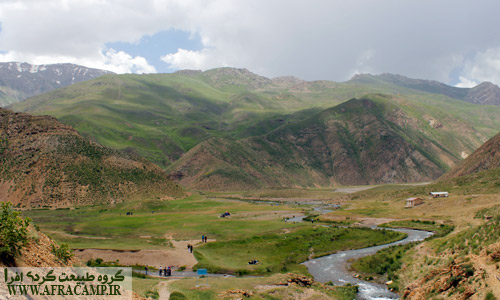The King and the old way(Haraz road, Mazandaran Province)
Haraz Road is the shortest route to get from the capital to the Caspian Sea plain that many times those who intend to travel to the territory to the north of Iran have crossed. In all the screws and the way in Haraz River Valley attractions that can be found along the way to see it and be fruitful journey. One of the most important historical and natural attractions tight strap-shaped cut and embossed Sassanid king and the broken bridge that is hidden in a valley behind Wana tunnel and it is necessary to see them go into the tunnel in the southern tip of South. Here is narrow and the way is very beautiful and well worth a stop and a visit to the.

On a journey that one of The purpose was to visit this area. We spent the night in Goznak in the beach park and after Seeing the general infidel, we cut our way to the shape of a king and a tight band. See this historical route that The forerunners of this land that have opened the way in the strait are very interesting and remarkable . The path that passes in some parts of it in the heart of the rock and indicates the special difficulty of the journey. Role The prominent shape of the king is almost in front of the second vent of the Van tunnel and Haraz is in this narrow It roars loudly. This is a memorial role of the Shah of Iran who has improved the route. Unfortunately, people's faces have been broken in recent years, and one wonders about this disease It is uncultured that they have damaged this role in such a way.
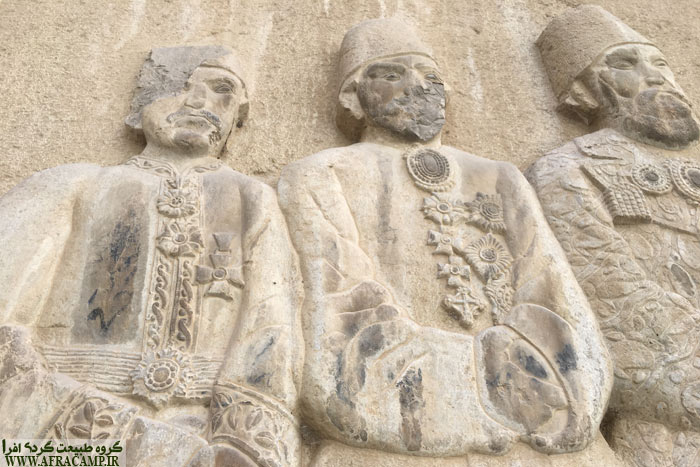


To learn more about The path and relief of the figure of the king in the continuation of a text from the book from Astara to Astarabad Dr. Sotoudeh is brought. To describe the path of Etemad-ol-Saltaneh's memoirs, which in 5 Azar 1254 Shamsi has narrated the route to Tehran in the footsteps of Naser al-Din Shah Is. Nasser al-Din Shah had a special interest in sightseeing and writing some travels by Etemad-ol-Saltaneh is very interesting and useful and shows a good image of that time. At The king was 44 at the time of the trip.




Cut in the time of Nasser al-Din Shah
Quoted from the book from Astara to Astarabad, Dr. Manouchehr Sotoudeh
Etemad Al-Saltanah wrote the following about the cut in 1292 AH:
We went through bad places again. We reached a point that was the hardest of all. They made it fairly well. The old Larijan road was on the right. There was no way at all. The mountain was a piece of rock and smooth. From the middle of the foot of this mountain, a platform has been closed with lime and stone, but the base of the platform has not reached the ground.. It is suspended between earth and sky. From these platforms, which were not more than one square in width, it was formerly the passage of convicts and hesitants of Mazandaran.. Jala is made so that the carriage passes. In this strait, he has carved the statue of Mubarak Shah on a stone, riding in formal clothes. Hassan Ali Khan Weir also benefits from standing on foot.(Etemad-ol-Saltaneh Memoirs Book, page 52)
Quoted from the book from Astara to Astarabad, Volume 3, Page 451




The figure of the king is cut in the strait:
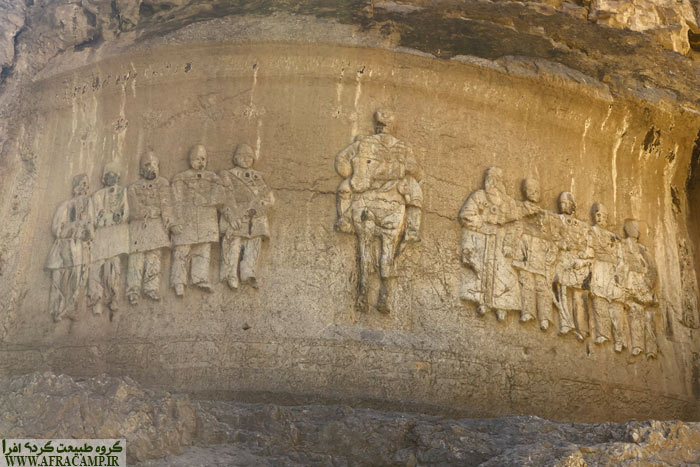


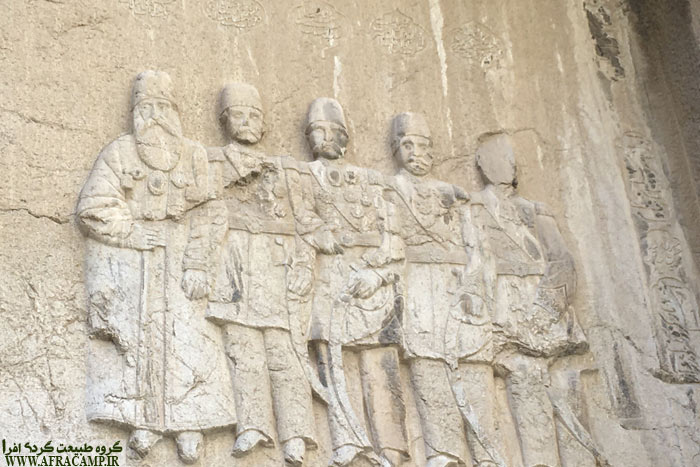
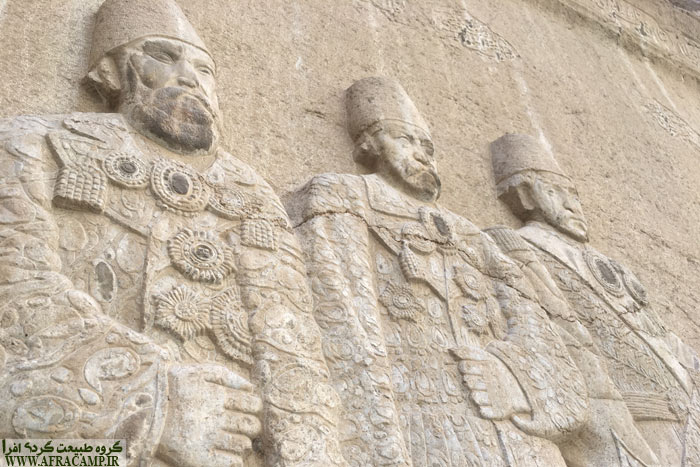
In the cut gorge, on the left side of Haraz water, a statue and inscription of Naser al-Din Shah are left.. Its height from the current floor of the road to below the role is 270 cm. The length of these engravings and inscriptions is eight meters and the width of the inscriptions that rotate around is 34 cm and the depth of the lower part of the figure is 160 cm..
In the form of Shah Nasser al-Din Shah, he is riding a horse in the middle, and five courtiers are sculpted on his right and five on his left..
These verses are engraved around this figure:
Top row:
Quoted from the book from Astara to Astarabad, Volume III
In the time of Nasreddin Shah Kamkar / The goat of justice sought the right path and found it
His command is straightforward in every way
Thank God that he chose such an empire for his own approval
The kings of Dehr are immortal for property / King Wayne poured out for the name
Everything raw was cooked in the end / Shine from the baked gold basket and raw wire
In the way of Larjan, which was the enemy, the work of John / Sometimes passing the caravan of complete neglect
The right row of stones:
Unsurprisingly, sometimes the passage of a giant / The first hymn is Bismillah, then he took a step
They did not bite the snake's share / And Andro Kenam, the lioness of Shirza Najst
Bottom horizontal row:
The way you wanted to be cut / You said no one should go to the trap
In Shahnameh, Zali is a legend / The legend that Abreh made in him Pour Sam
With the comfort of Mazandaran land / The ruling of Sari is the emperor of this position
It was opened because the floor of Karim belonged to Malik / The road that was closed was like Latham's forehead
Carved stone by Khosrow Farhadsan / He made an image of Shah Parviz Ehtesham
The headless estuary of the mountain erupted / Because the crown of Shahriar arose from Raham
They asked for the date of the emperor / Because it was a special service to praise the slave
Mohsen Mirzaei Engineer . Raqma Abolfazl Savoji
Aam Banash Khameh Rezvan wrote and read
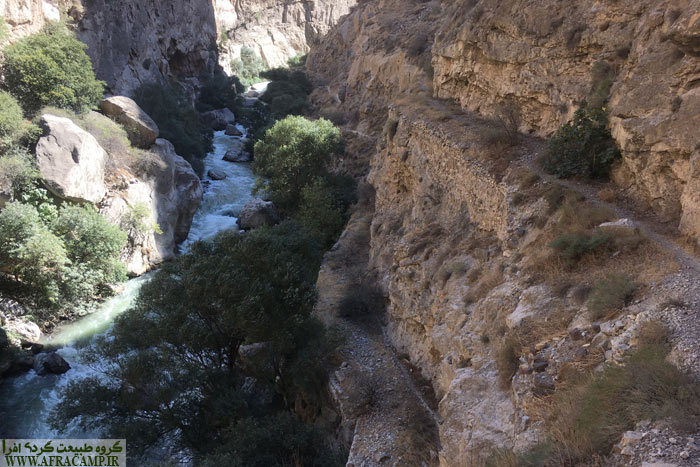
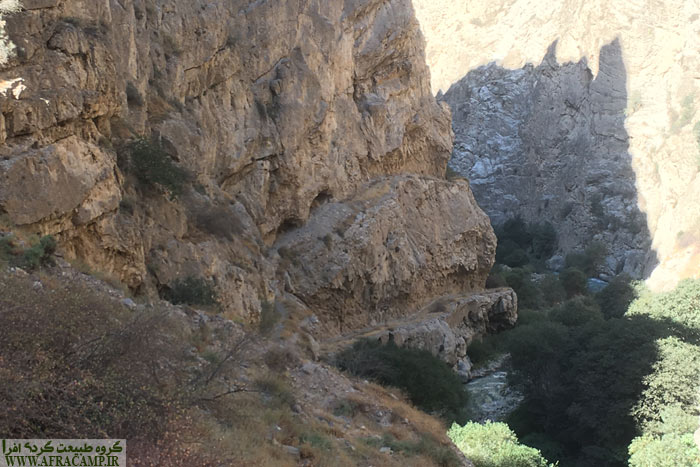

A stone and mortar bridge was cut near the end of the gorge:
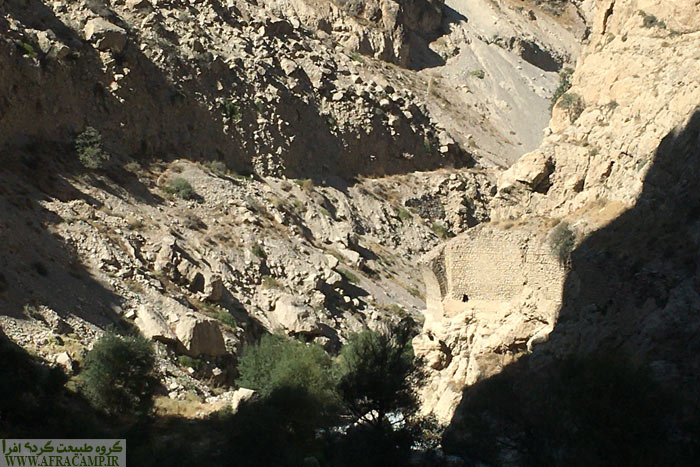
Near the northern mouth of the tunnel, which has been cut on the right side of the gorge, is an iron bridge that can be crossed to reach the left hand side of Haraz water.. About one kilometer, when we went south on the left road of Ab Haraz, we reached a broken bridge. Its right base and some of its arch crescent remain to this day. The old road, which apparently belongs to the Sassanid period, came from the right side of Haraz water by crossing this bridge to the left of the water.. Some old road, on the right side of the water that leads to this bridge, can be seen on top of a wall of stone and plaster..
From Astara to Astarabad, Volume 3, Page 451
The way to get in shape شاه:

Reaching path from the side Tehran is such that after crossing Goznak, Shahandasht and Amiri, it enters the Wana tunnel. Receipt. Before the tunnel on the left is the path of a parking lot to go. after The car park is about a quarter walk up to the relief. The road is almost smooth and light Is. To go to the ancient Sassanid bridge, you have to continue the route for another quarter to It came close. The route at this price is steep and should be along the route at that height Takes a lot of valley very careful.

Every time I travel to the point of Iran, the magnitude and diversity of this land is ... Mdhvshm's not all ...

